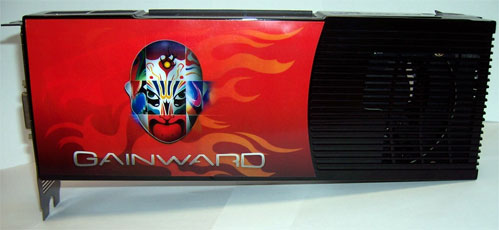
Review: Geforce 9800GX2 is super fast
Geforce 9800 GX2 is the first complete high-end card, at least that's how Nvidia describes it in its own words. Let's not look back at all the shortcomings of the 8800 Ultra, but take a peak at what the 9800 GX2 has to offer. This is the fastest graphics card ever made, but in fact it's two graphics cards stapled together. Nvidia will probably say that the 9800 GX2 combines the power of two 9800 GPUs with a grand total of 256 stream processors and an earth shuddering 1GB frame buffer (512MB per core). Obviously, the card is a dual slot design and it looks sexy, but also elegant, as it is encased in an all metal body.

A picture of the reference card (above) and Gainward's card (below).

The combined power of two GPUs is not the only good thing about this card. Pure Video HD technology, first seen on G92 based cards, is now an integral part of the package and that's one of the reasons Nvidia calls its new flagship a complete solution, as it gets you top notch performance as well as multimedia capabilities.

The complete package looks robust and sturdy. The fan is inside the metal case and there's no way you can damage it, or any other part of the card, for that matter.
Its GPU duet works, thanks to new SLI technology. The driver manages them by using 4-way alternate frame rendering (AFR), and scaling is easy. It's also possible to use two 9800 GX2 cards in a Quad-SLI setup.

ATI managed to do pretty much the same thing with its HD3870 X2 card, but it used just one PCB. Nvidia took another approach and it's still using two PCBs.
You can see how the GPUs are mounted on the picture above, each on its own PCB facing the other. This allowed the engineers to squeeze the cooler in between, sandwiched between the two PCBs. The fan scoops up cold air through the sides and the rear of the card and forces it through the card. Most of the hot air exits the card on top and if you haven't got some serious airflow in the your chassis, this might be an issue. The card can withstand temperatures of up to 105°C, although we doubt that it will ever get that hot. If you somehow manage to push it so hard and reach this temperature, it will automatically downclock to reduce heating, and if that doesn't turn out to be enough, it will just shut down to prevent failure. During our test we measured 81°C under load and 68°C in idle.

The 65nm GPUs have 1508 million transistors in total, if we combine them. They are clocked at 600MHz with a Shader clock of 1500MHz and these numbers are similar to those we already saw on 8800 GT cards. It has a total of 256 stream processors (128 per GPU). The memory is clocked slightly higher than on previously seen G92 cards. Geforce 9800 GX2 uses memory clocked at 1000MHz, slightly more than the 900MHz and 970MHz seen on the 8800 GT and GTS, respectively. The memory bus is 256-bit and the card packs 2x512MB of GDDR3 memory.

A look at the top of the card shows where the power connectors are hidden. With the new cooler design even the SLI and SPDIF connectors have small caps, which protect them and help the card look a bit more elegant.
According to the specs the card should consume more than 197W and Nvidia recommends a 580W PSU for a single card configuration and an 850W PSU for a dual card SLI setup.
Be sure to check if your PSU has an 8-pin PCIE power connector, as you will need it as well as a 6-pin connector. It sounds funny, but some 8-pin connectors won't fit into the connector on the card and Nvidia suggests you push them in using force. Don't push your luck with such a pricey piece of hardware. It's much better to cut off a piece of plastic on the connector. This problem will soon be fixed by PSU manufacturers who caused it in the first place by not sticking to the specifications.

HybridPower technology is a novelty which we already saw in action and we liked the idea very much. It allows the card to power down when we're not using demanding 3D applications. Of course, at the moment this only works with the 780a high-end AMD chipset with integrated graphics. Intel versions should appear in Q2.

This lets us save a lot of power and you can get a general idea of how it works on the slide above. When we don't need a discrete GPU, Nvidia's integrated graphics kick in and help us reduce power consumption. It will for 2D, undemanding 3D or watching HD video. We saw HybridPower in action at CeBIT, but it was necessary to shut down the 9800 GX2 manually. We're assuming that this action is now controlled automatically. HybridPower will be a feature of all upcoming Nvidia chipsets.
At the back we've got two DVI connectors as well as one HDMI. You no longer get an HDMI converter in the box, since HDMI is now an integral part of the reference design. An SPDIF cable is still necessary to channel sound through the card to the HDMI connector and you'll get it in the box.

You can see the tiny holes above the HDMI connector. These are, in fact, LEDs, used to show you which state the card is in. The DVI connector which should be used for your main display is marked with a 1. We didn't try to connect three displays using the HDMI out, but we will get around to it sooner or later.
Here's the layout of the connectors, borrowed from Nvidia.

Of course, the card uses PCI Express 2.0, supports Vista, or should we say, DirectX 10.
You already saw that the card has a single SLI connector and this means you can use it in a Quad-SLI setup, but not in Tri-SLI. Quad-SLI works well and it will be launched any day now. We saw it scale well using two 9800 GX2 cards. In order to make this possible, Nvidia turned to 4x AFR (Alternate Frame Rendering). This means that it can render 4 frames simultaneously, but this depends on OS framework support ,which we currently have only in Vista.
Gainward uses its standard packaging, and we already saw that it ships with an SPDIF cable. You'll also get Tomb Raider Anniversary with it.
![]()


Testbed
Motherboard:
EVGA 680i SLI (Ustupio EVGA)
Processor:
Intel Core 2 Duo 6800 Extreme edition (Ustupio Intel)
Memory:
OCZ FlexXLC PC2 9200 5-5-5-18 (Ustupio OCZ)
na testu CL5-5-5-15-CR2T 1066MHz at 2.2V
PSU:
OCZ Silencer 750 Quad Black ( Ustupio OCZ)
Hard disk:
Seagate Barracuda 7200.9 80GB SATA (Ustupio Seagate)
CPU-Cooler:
Freezer 7 Pro (Ustupio Artic Cooling)
Case Fans:
Artic Cooling - Artic Fan 12 PWM
Artic Cooling - Artic Fan 8 PWM
Futuremark tests

In 3Dmarku03 the Radeon 3870 X2 is slightly faster, but in 05 and 06 the advantage is on Nvidia's side. In this case the 3Dmarks don't do the card justice, as in actual games the Geforce GX2 is much faster than the twin-headed ATI.
Games

Without FSAA and Aniso, Gainward's 9800 GX2 is around 12 percent faster than the Radeon 3870 X2. However, as soon as you turn on FSAA and Aniso, the Radeon falls back by 17 percent. Over 100 FPS at 1920x1440 with 4X FSAA and 8X Aniso is an impressive score.

At 1280x1024 with eye candy the Gainward 9800 GX2 is about 22 percent faster than the Radeon 3870 X2. At 1600x1200 with 4X FSAA and 8X Aniso the GX2 is 47.5% faster. This is a huge difference. Even at 1920x1440 with 4X FSAA and 8X Aniso Nvidia is around 35 percent faster.

Ah, Crysis. Even with the mighty Geforce 9800 GX2 it barely goes over 50 FPS, without FSAA and Anisotropic filtering. Still, the difference compared to Radeon 3870 X2 at 1280x1024 4X FSAA, 8X Aniso is a huge 83 percent. At 1600x1200, 4X FSAA, 8X Aniso it increases to almost 86 percent. In plain FPS, Gainward gets us a playable 28.8 FPS, while the 3870 X2 manages just 15.5 FPS.
Obviously, you will need two GX2 cards to enjoy Crysis at 1920x1200 or higher.

World in Conflict under XP definitely loves the Radeon 3870 X2, at least at lower resolutions and settings. Only at 1920x1440 with 4xFSAA and 8X Aniso the Geforce 9800 GX2 manages to outperform the Radeon and score 26.6 percent more.

In Half Life 2 ATI scores better at 1280 with effects and 1600 without eye candy. Even the 8800 Ultra manages to outperform the Geforce 9800 GX2 on the first two resolutions, but at higher ones the dual GPU 9800 GX2 shows its teeth.
At 1600x1200 with 4x FSAA and 8x Aniso the Geforce 9800 GX2 is almost 18 percent faster, while at 1920x1440 with 4x FSAA and 8x Aniso it scores 41 percent more.
Conclusion
Even at reference clocks the Gainward 9800 GX2 manages to drastically outperform Radeon 3870 X2 cards.
It needs higher resolutions to show what it's capable off, but then again, you won't spend €550 to play in 1024x768. This card is at home at high resolutions and high settings and in these circumstances it leaves the Radeon 3870 X2 behind in a cloud of dust.
The 8800 GTX and Ultra can enjoy their retirement days knowing that the GX2 offspring is more than capable of taking care of family business. It is much faster than its predecessors and even at these prices it's a good investment if you've got a screen capable of handling high resolutions.
It's much faster than the Radeon 3870 X2, but at the same time it is much faster in many scenarios. If you want the fastest card on the planet, we can easily recommend it. Only the overclocked 9800 GX2 cards will be faster.

